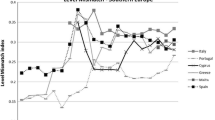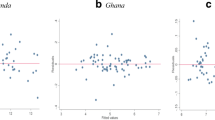Abstract
For the Norwegian economy, 2003–2013 was a period of large growth and big business cycle fluctuations. The aggregate uv-curve reflects this and shows a reduction in both the vacancy rate and the unemployment rate from 2003 to 2013, suggesting improved labour market matching over the period. The inclusion of Eastern European countries in the European Union in 2004 and 2007 caused an increasing influx of foreign job seekers. I quantify regional and occupational mismatch, and make a distinction between natives and immigrants. Indicators show no reduction in mismatch over time, which therefore cannot account for the increased labour market efficiency that the uv-curve suggests. However, ‘footloose’ immigrants seem to have adapted better than ‘rooted’ natives to the structure of labour demand in the regional dimension, and thus to have contributed to a lower level of mismatch than would have resulted without immigrants. In the occupational dimension immigrants made no significant difference. Levels and differences in employment and unemployment among and between immigrants and natives were not well explained by their education levels or types.







Similar content being viewed by others
Notes
In the literature many authors do not distinguish between the empirical uv-curve and the theoretical Beveridge curve, but use the two terms interchangeably.
The approximate equality of the variance expression and the logarithmic expressions of M u and the coefficient ½ comes from expanding log(u s /u) around 1 and weighing with each sector’s share of the labour force, see Layard et al. (1997, ch. 6.3) for derivations based on economic theory.
In the expression for M U,V , the factor 2 comes from assigning equal elasticity ½ to U and V in the Cobb-Douglas form of a hiring function (making U and V equally important) and assuming that the sum is larger than ½ and closer to 1. See Layard et al. (1997, ch. 6.6) for derivations based on economic theory.
A time subscript t was dropped to simplify notation and make the formulas easier to read.
Dividing by 2 is necessary to get the proportion that equalises the shares, e.g. two groups of 11 and 7 persons are equalized to 9 persons each by moving (11–7)/2 = 2 persons from the larger to the smaller group.
Eleven yearly observations are too little for calculations of reliable second order moments like correlations. The data also have to be stationary (no trend) for correlations not to be spurious. Nevertheless, the only meaningful correlation is between M u and M U,V for natives (and for all) in counties: 0.75. The other series either have low correlation, or very high correlation due to trends.
Immigrants increased in construction, services, engineering and ICT; natives in health and care, education and academia.
Reduced differences between the proportion of immigrants and the proportion of natives that were unemployed in manufacturing, engineering and ICT, children and youth work.
References
Bonthuis, B., Jarvis, V., & Vanhala, J. (2015). Shifts in euro area Beveridge curves and their determinants. Bank of Finland research discussion papers, (Vol. 2) 2015.
Canon, M. E., Chen, M., & Marifian, E. A. (2013). Labor mismatch in the great recession: A review of indexes using recent U.S. data. Federal Reserve Bank of St. Louis Review, 95(3), 237–271.
Duncan, O. D., & Duncan, B. (1955). A methodological analysis of segregation indexes. American Sociological Review, 20(2), 210–217.
Dur, R. A. J. (1999). Mismatch between unemployment and vacancies in the Dutch labour market. Applied Economics, 31, 237–244.
Elsby, M. W. L., Michaels, R., & Ratner, D. (2015). The Beveridge curve: A survey. Journal of Economic Literature, 53(3), 571–630.
Entorf, H. (1998). Mismatch explanations of european unemployment. Berlin: Springer.
Flisi, S., Goglio, V., Meroni, E. C., Rodrigues, M., & Vera-Toscano, E. (2016). Measuring occupational mismatch: overeducation and overskill in Europe—Evidence from PIAAC. Social Indicators Research. doi:10.1007/s11205-016-1292-7.
Haincourt, S., & Mogliani, M. (2012). Has the 2008–2009 recession increased structural unemployment in the euro area? Quarterly Selection of Articles, Banque de France, 25, 63–80.
Hobijn, B., & Sahin, A. (2013). Beveridge curve shifts across countries since the great recession. Federal Reserve Bank of San Francisco working paper, 2012–24.
Jackman, R., & Roper, S. (1987). Structural unemployment. Oxford Bulletin of Economics and Statistics, 49(1), 9–36.
Kolsrud, D., Røed, M., Schøne, P., & von Simson, K. (2016). Bidrag og belønning—om innvandrere i det norske arbeidsmarkedet. Rapport 2016:04. Institute for social research. Oslo.
Layard, R., Nickell, S., & Jackman, R. (1997). Unemployment. Oxford: Oxford University Press.
Morgado, A., Sequeira, T. N., Santos, M., Ferreira-Lopes, A., & Reis, A. B. (2015). Measuring labour mismatch in Europe. Social Indicators Research. doi:10.1007/s11205-015-1097-0.
Ochsen, C. (2009). On the measurement of mismatch. Applied Economic Letters, 16, 405–409.
Pisarides, C. A. (2013). Unemployment in the great recession. CEP discussion paper no 1210. London: Centre for economic performance, London School of Economics.
Zimmer, H. (2012). Labour market mismatches. National Bank of Belgium Economic Review, 55–68. https://www.nbb.be/doc/ts/publications/economicreview/2012/ecorevii2012_h4.pdf.
Acknowledgements
This paper builds on chapter 2 in Kolsrud et al. (2016), which reports (in Norwegian) research by Statistics Norway and by the Institute for social research, commissioned by the Ministry of labour and social affairs. Thanks to Anders Ekeland for preparing the data, and to two referees, whose comments greatly improved the presentation.
Author information
Authors and Affiliations
Corresponding author
Appendices
Appendix 1: uv-Curves for 19 Counties
See Fig. 8.
(Disaggregated) uv-curves for each county (black) superimposed on the national uv-curve (grey). The developments of the county uv-curves are quite similar to the development of the aggregated, national uv-curve. The improvement of the labour market efficiency suggested by the national curve is thus not a purely aggregated phenomenon, but rather seems to have taken place in many local labour markets. In the lower right panel the curve for Finnmark county is dashed to separate it from Troms county, and to signal that this county had an atypical labour market evolution
Appendix 2: uv-Curves for 14 Occupation Groups
See Fig. 9.
(Disaggregated) uv-curves for each group of occupations (black) superimposed on the national uv-curve (grey). The uv-curves for occupation groups are less similar to the aggregated, national uv-curve than are the county uv-curves. Business cycle movements are distinct. However, the labour market efficiency does not seem to have improved from 2003 to 2013 for the three occupation groups above. uv-curves for each group of occupations (black) superimposed on the national uv-curve (grey). Labour market efficiency seems to have improved from 2003 to 2013 for most occupation groups
Appendix 3: uv-Curves for 4 Education Levels/Lengths and 2 Types of Higher Education
See Fig. 10.
Appendix 4: Co-development of Unemployment Share and Vacancy Share
The mismatch indicator M U,V sums up differences between each sector’s share of all vacancies and its share of all unemployed job seekers each year. Figure 11 graphs the co-development of each occupation group’s share of all unemployed job seekers (horizontal axis, percent) and its share of all vacancies (vertical axis, percent). On the diagonal there is no mismatch: the share of vacancies equals the share of all unemployed. The horizontal = vertical distance of a year point on a graph to the diagonal is a measure of mismatch in the occupation group. The distance is different from, but highly correlated with, the measure used in the mismatch indicator M U,V . The occupation groups with the largest distances to the diagonal—i.e. occupation groups that contributed most to the mismatch some years—are emphasised with bold slanted type. Note that mismatch varied from year to year, and significantly over the period 2003–2013. While mismatch was high in Construction in the depression in 2009, it peaked in 2012 in Engineering and Information and Communication Technologies.
Co-development of each occupation group’s share (in percent) of all unemployed job seekers (horizontal axis) and its share of all vacancies (vertical axis). The occupation groups in slanted bold type are the ones with the largest contribution some years to occupational mismatch. The upper row and lower row of panels show graphs for all (natives + immigrants) and immigrants only. Graphs for natives only are almost indiscernible from the graphs for all (upper panels), and not shown
Figure 12 shows the co-development of three populous counties’ share of all unemployed job seekers (horizontal axis, percent) and its share of all vacancies (vertical axis). The horizontal = vertical distance from each year point on a graph to the diagonal reflects mismatch in the county. Oslo had up to twice as many unemployed and vacancies as the next counties (Akershus, Rogaland, Hordaland). Hence, Oslo had up to twice their shares of all unemployed and vacancies. For immigrants only, Oslo’s numbers and shares are 3–5 times higher than the other counties. For most counties there were larger dynamic fluctuations in the vacancy share than in the share of unemployed in the period 2003–2013. Resource based coastal counties (oil, fish) had graph developments more orthogonal to the diagonal, i.e. negatively correlated development in vacancy shares and unemployment shares.
Rights and permissions
About this article
Cite this article
Kolsrud, D. Mismatch in the Norwegian Labour Market 2003–2013: Did Immigrants Make a Difference?. Soc Indic Res 137, 979–997 (2018). https://doi.org/10.1007/s11205-017-1628-y
Accepted:
Published:
Issue Date:
DOI: https://doi.org/10.1007/s11205-017-1628-y









